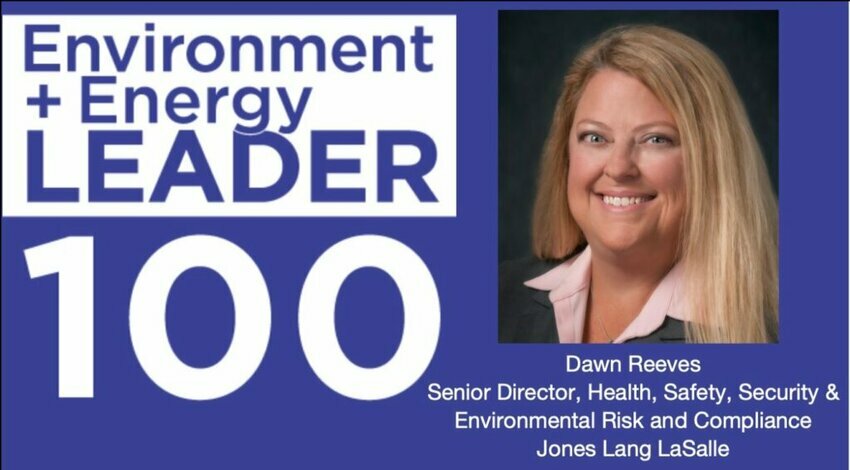
The Environment+Energy Leader Honoree program is an annual list that recognizes the environment and energy “doers” who break trail in creating new solutions, programs, platforms, best practices and products to help their companies – or other companies – achieve greater success in commercial and industrial environment and energy management. Meet the Honorees… is an ongoing series that will feature one E+E Honoree from 2022 each week. See the complete list of 2022 Honorees here.
Meet Dawn Reeves, senior director of health, safety, security and environmental risk and compliance with Jones Lang LaSalle. Dawn is responsible for overseeing those efforts at more than 2,500 facilities totaling almost 27 million square feet. This includes employee health and safety, OSHA compliance, audits, training evaluations, incident trending, indoor air quality, and vendor management. The management of environmental risk for her clients involve asbestos compliance administration, clean air act reporting, handling of regulated waste, executing transactional environmental due diligence, development of refrigerant handling best practices, site remediation, compliance with stormwater, wastewater, drinking water and wetlands regulations.
What is your biggest environmental challenge?
Dawn Reeves: Currently, one of our largest environmental challenges is the management of asbestos and the common misconception that building materials in structures built after 1980 are not of concern. During asbestos surveys, we routinely identify asbestos containing materials (ACM) in facilities built in the 2000s. To address this, we place asbestos warning signs in, for example, electrical/telecom rooms and cleaning/janitorial closets to alert contractors that they need to verify if any ACMs are present by inquiring with the facility manager. We also add asbestos warning language to all work orders. For our client, we manage an extensive asbestos inventory and have developed an easy and quick way to deliver asbestos data to those who may impact building materials. When facilities receive structural or interior damage, asbestos data is automatically sent to the facility manager to share with contractors.
What was a successful project or implementation you worked on that you can share?
DR: A successful project that we have rolled out recently is our refrigerant destruction program. My client has a very pro-active stance on refrigerant and has a directive in place to destroy all Class I and Class II refrigerants that are removed from their equipment. Reclamation and reintroduction into the market is not an option. To do this with a mobile technician model servicing thousands of retail locations was a challenge, especially since the client has strict record-keeping and reporting requirements. We worked with one of our EHS suppliers to create a “mail-back program” for used refrigerant. Technicians use their recovery cylinders to hold refrigerant removed during repairs that cannot be returned to the system. When the cylinder is full, they contact the vendor who sends a questionnaire to be completed (refrigerant type, what facilities were serviced, cylinder size, etc.) along with all of the shipping labels. The refrigerant cylinders are transported by a national carrier to the destruction facility. Destruction records are maintained and available to the client upon request. The process is working smoothly and has been a success for our account and our client.
What trends do you expect to see in the market in the next few years? What challenges will the industry face and what technologies or organizational changes will overcome them?
DR: With an aging population of specialized and general maintenance technicians, we will need to rely heavily on data analytics and satellite imagery to assist with information collection and compliance. Fewer “boots on the ground” means that compliance may trend towards a desktop solution versus on-site auditing/inspections. For example, instead of having technicians perform site visits to provide information on fall protection needs, we can use satellite imagery and other technology to review the rooftop, measure distances from equipment to roof edge and identify sites that are high-risk. Regulatory agencies, with their reduced resources, will need to embrace this approach as well, to increase discovery of non-compliance and enforcement.
Can you tell us about a recent interest that has had an impact on you and your work?
DR: I live next to a “Century Farm” (farmland owned by the same family for over 100 years). When one of the last remaining heirs was in poor health, the farm was sold to a developer. The first thing I thought about was how my land was going to be impacted by all the stormwater runoff from the new development. It made me think about the lack of smart-growth planning in my county and the general issues when high density development clashes with existing aesthetics of a community.
This personal experience has led to a heightened awareness of how my client’s development impacts others and how my department can continue to play a positive role – reducing UPS battery banks, improving scheduled generator run-times, compliant stormwater inspections, proper chemical storage, cooling tower optimization, etc.
Editor’s note: nominations are now open for this year’s E+E Honorees. Nominate a colleague — or yourself — for the 2022 E+E Honoree list today.